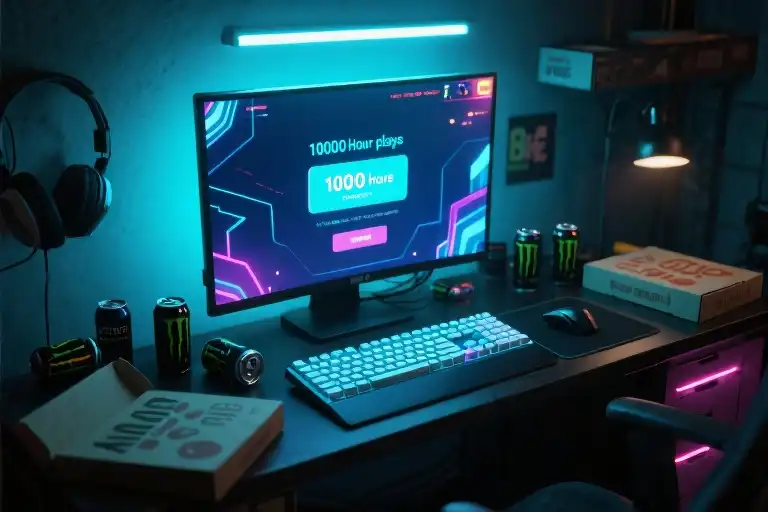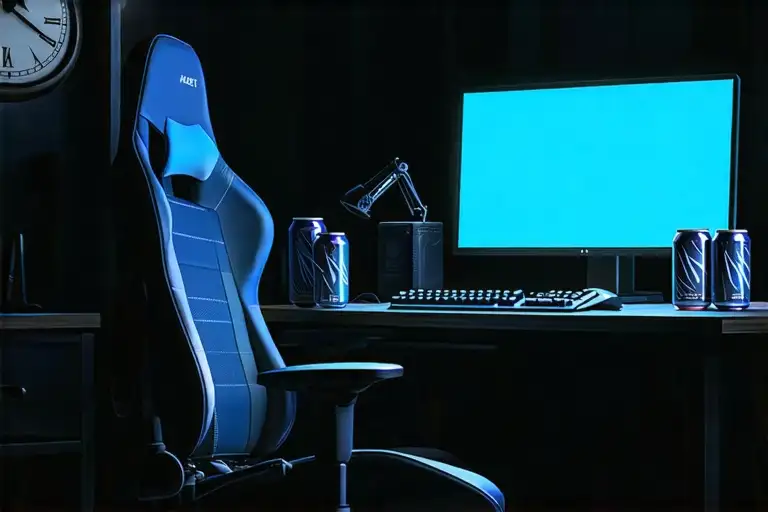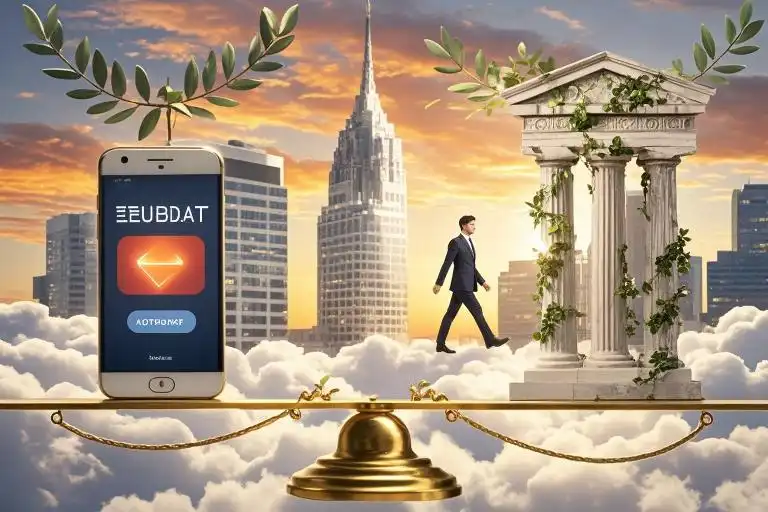The glow of my monitor was the only light in the room as the clock ticked past 3 AM on my 17th birthday. My right wrist throbbed with a dull ache from twelve consecutive hours of mouse-clicking, and my vision blurred slightly from staring at the flickering screen. Empty energy drink cans formed a small aluminum fortress around my gaming chair – the only birthday decorations I needed that year.
Then it happened. A small notification popped up in the corner of my League of Legends client: ‘Congratulations! You’ve reached 10,000 lifetime hours played.’ The cheerful yellow exclamation point might as well have been a slap across the face. I sat frozen, suddenly aware of the cramp in my legs from sitting motionless for half a day, the stale taste of microwave pizza in my mouth, and the eerie silence of a house where everyone else had gone to sleep hours ago.
Ten thousand hours. The number echoed in my sleep-deprived brain with terrifying clarity. That’s 416 full days. Nearly six years of full-time employment. Enough time to earn a PhD with summers off. My teenage years had quietly disappeared into this digital rabbit hole, one match at a time, while the world outside kept turning.
Outside my window, dawn was breaking over the neighborhood. Somewhere down the street, I imagined my classmates still asleep after an actual birthday celebration – the kind with real laughter and human connection instead of pixelated victory screens. The notification still blinked patiently, waiting for me to click it away and queue up for another match. But for the first time in years, I hesitated. That innocent-looking number held up a mirror to my life choices in a way no concerned parent or teacher ever could. It wasn’t about morality or wasted potential – just simple, brutal arithmetic.
What does 10,000 hours actually buy you in the real world? The question hung in the air like the blue light haze from my monitor. I knew exactly what it bought in League of Legends – every champion mastered, every rank achieved, every late-night adrenaline rush of a close match. But as my virtual trophy case overflowed, I realized with creeping dread that my real-world resume remained stubbornly empty. The skills that mattered most – maintaining relationships, discovering passions, building resilience – couldn’t be unlocked with XP points.
That birthday morning marked the beginning of my uneasy relationship with video game addiction. Not with some dramatic uninstall moment (I’d relapse many times in the coming years), but with the first genuine flicker of doubt about the opportunity cost of those glowing screens. The toothpaste of time, as I’d later come to call it, had been squeezed out tube by tube into a virtual sinkhole, and no amount of wishing could put it back.
The Black Glory: Chronicles of My Esports Adolescence
My teenage years were measured not in semesters or birthdays, but in ranked seasons and patch updates. From 2012 to 2016, my life operated on a precise 6.5-hour daily gaming cycle – the exact duration needed to maintain Challenger tier in League of Legends while technically still attending high school. The math was brutal in its efficiency: 45-minute classes became cooldown periods between gaming sessions, lunch breaks transformed into meta-analysis discussions, and homework was that annoying loading screen before the real work began.
The Double Helix of Rank and GPA
The correlation between my virtual and academic standings would make any statistician wince. As my League ranking climbed from Silver to Diamond, my report cards performed the exact inverse maneuver. Each promotion series coincided with skipped assignments, every victorious streak mirrored by declining test scores. By junior year, I could recite champion ability ratios faster than chemical equations, and my map awareness extended far beyond anything covered in geography class.
Three distinct patterns emerged in this self-destructive rhythm:
- The Pre-Exam Surge: Intense 72-hour gaming binges always preceded major tests, fueled by paradoxical ‘I’ll study tomorrow’ logic
- The Weekend Illusion: Friday promises of ‘just one game’ inevitably dissolved into Sunday night regret
- The Patch Cycle: Every game update brought renewed obsession, resetting any progress toward moderation
The Relapse Diaries
My attempts to quit followed the tragicomic pattern of a nicotine addict:
Attempt #1 (Age 15): Cold turkey deletion after failing algebra. Lasted 11 days – exactly until the next champion rotation.
Attempt #2 (Age 17): The ‘Healthy Balance’ phase. Installed parental control software… on my parents’ devices. Maintained for 3 weeks before discovering VPN workarounds.
Attempt #3 (Age 19): The grand ‘Replacement Theory’ experiment. Bought a guitar, gym membership, and coding textbook. All collected dust while I achieved Platinum III.
What these cycles revealed wasn’t just lack of willpower, but how thoroughly gaming had rewired my reward system. The instant gratification of +18 LP from a ranked victory created neurological pathways that made slower, real-world achievements feel insignificant. My brain had become a slot machine that only paid out in virtual currency.
The Hidden Curriculum
Paradoxically, my esports obsession did teach me unexpected skills – just not the kind that appeared on transcripts:
- Resource Management: Efficiently allocating 1850 gold for optimal item builds
- Team Coordination: Shotcalling in high-pressure Baron contests
- Data Analysis: Memorizing hundreds of champion cooldown timers
These became my secret shame during college interviews. When asked about leadership experience, I could only describe orchestrating five-man dives on mid lane turrets. Questions about perseverance brought stories of climbing through ELO hell. The worst moments came when adults asked what I’d do if the internet disappeared – and realizing I had no answer.
This chapter of my life wasn’t just about wasted time, but about how easily virtual validation can replace real growth. The ranking system provided clear metrics of progress that real-world development lacked, creating a dangerous illusion of achievement. My teenage self would proudly declare ‘I’m in the top 0.1% of players!’ without recognizing that percentage measured nothing beyond itself.
The true cost became visible in what I didn’t have – the friendships not formed during lunch periods spent theorycrafting, the muscles not built during summers indoors, the creative projects never started because ‘one more game’ always took priority. My high school yearbook shows a ghost – present in class photos but absent from club pages, remembered for my KDA ratio rather than any meaningful contribution.
Yet even in this darkness, glimmers of potential shone through. The strategic thinking honed in virtual battles later helped me solve complex work problems. The teamwork skills eventually translated to office collaborations. But these were accidental benefits, not intentional growth – like surviving a shipwreck and calling the floating debris a life raft.
What might have happened if I’d directed even half that intensity toward tangible skills? That question haunts the next chapter of this story.
The Road Not Taken: What My Gaming Addiction Cost Me
At my high school reunion last summer, something became painfully clear. As we went around sharing life updates, a pattern emerged. The classmates who’d spent their teens playing sports were now fitness trainers or weekend marathoners. The theater kids had blossomed into confident public speakers. Even the quiet bookworms had built impressive careers in law and academia.
Then there was me – the guy who could recite League of Legends champion stats but struggled to make eye contact during small talk. Our alumni survey revealed stark contrasts:
- Income: Non-gamers averaged 28% higher salaries
- Relationships: 72% of them were in committed relationships vs. 33% in the gaming group
- Health: Gamers reported 3x more cases of chronic back pain and insomnia
The real wake-up call came when Sarah, my high school crush, asked that simple question over punch: “So what do you do for fun these days?” My mind went blank. After a decade of gaming, I had no interesting hobbies, no travel stories, no passion projects to share. Just memories of pixelated victories that meant nothing in that moment.
The Opportunity Cost Calculator
Let’s break down what those 10,000 gaming hours could have bought:
| Hours Invested | Skill Developed | Real-World Equivalent |
|---|---|---|
| 2,000 | Language Learning | Fluent in Spanish + Mandarin |
| 4,000 | Music Practice | Professional piano competency |
| 3,000 | Writing | Three published novels |
| 1,000 | Fitness Training | Marathon-ready endurance |
That remaining 10% free time? More than enough for a social life. The math doesn’t lie – we all have the same 168 weekly hours. It’s just that mine were spent chasing digital dragons while others were building actual lives.
The Social Skills Deficit
Gaming provided instant camaraderie through headsets, but left me unprepared for real human connection. Consider these sobering comparisons:
- Teamwork: Raiding guilds taught me coordination, but not how to resolve office conflicts
- Communication: I could shot-call in Discord, yet froze during job interviews
- Emotional IQ: Recognizing champion abilities ≠ reading room dynamics
That reunion highlighted what psychologists call “experience gaps” – the social milestones I missed while glued to screens. First kisses. Road trips. Late-night dorm room debates. These can’t be downloaded as DLC later in life.
Reframing the Narrative
This isn’t about shaming gamers (I still enjoy the occasional match). It’s about awareness – recognizing that every hour in Azeroth is an hour not spent:
- Building your body at the gym
- Networking at industry events
- Creating art that outlasts server shutdowns
The good news? Unlike my teenage years, we now have tools to track and balance gaming. Apps like Forest gamify productivity. Discord servers exist for every real-world hobby. That 10,000-hour theory works both ways – what could you master by redirecting just half your gaming time?
As I left the reunion that night, Sarah’s parting words stuck with me: “You were always the smartest guy in class – imagine what you could’ve done.” For the first time, I started imagining too.
The Alchemy of Time: Reforging 10,000 Hours
That moment when Steam’s annual recap flashed my total playtime – 10,217 hours – felt like taking a bullet to the chest. The number glowed mockingly, quantifying what I’d always suspected: I’d invested the equivalent of five full-time work years into digital worlds. But what if we could reverse-engineer this obsession? Let’s conduct a thought experiment using Dr. Ericsson’s deliberate practice framework.
Skill-Type Conversion: The Prodigy Path
Scenario 1: Music Mastery
At 3 hours daily practice (standard for conservatory students), 10,000 hours equals roughly 9 years. By age 25, I could have:
- Achieved ABRSM Grade 8 in piano/violin
- Composed original symphonic works
- Performed at regional orchestras
Economic Impact:
Music teachers average $40/hour (US Bureau of Labor Statistics). Even teaching part-time, that’s $208,000 in potential earnings versus $0 from ranked matches.
Creation-Type Conversion: Building Real Assets
Scenario 2: Content Creation
Allocating those hours to writing at 500 words/hour (professional pace):
- 5 million written words
- 50 full-length novels or 2,500 blog posts
- YouTube equivalent: 3,333 videos at 30min/edit
Platform Growth:
Consistent creators hitting 10k hours typically achieve:
- 50k+ newsletter subscribers
- 6-figure ad revenue (Median Google AdSense: $5 RPM)
- Published book deals
Physical Transformation: The Athlete’s Journey
Scenario 3: Athletic Training
Following Olympic training regimens (4h/day, 6 days/week):
- Marathon: Sub-3 hour finish (2,500h threshold)
- Swimming: NCAA Division I qualifying times (~3,000h)
- Basketball: Semi-professional league readiness
Health Dividend:
CDC studies show active adults save $2,500+/year in medical costs. Compound that over a decade – that’s a down payment on a house versus repetitive strain injuries from gaming.
The Hybrid Approach
Most realistic is balanced reinvestment:
- 4,000h: Coding (Full-stack developer competency)
- 3,000h: Language learning (4 languages to B2 level)
- 2,000h: Fitness (Elite amateur athlete status)
- 1,000h: Social development (Meaningful relationships)
Key Insight:
Unlike RPG skill trees, real-world abilities compound. Learning programming enhances logical thinking for music composition. Athletic discipline transfers to work ethic. This interconnectivity creates exponential returns gaming can’t match.
Your Personal Conversion Calculator
Try this mental exercise:
- List your top 3 wasted-time activities
- Multiply hours spent by $25 (modest hourly value)
- Research what equivalent training achieves
When I did this, seeing “$250,000” next to “Diamond rank in League” triggered my final uninstall. Your turn.
The Toothpaste Theory: Seven Truths About Time’s Irreversibility
That moment when you squeeze toothpaste out of the tube, there’s no pushing it back in. Time works exactly the same way – once spent, it’s gone forever. This fundamental truth hit me hardest when analyzing my 10,000 lost gaming hours through different philosophical lenses.
1. The Thermodynamics of Time
Every gamer knows the second law of thermodynamics unconsciously: entropy always increases. Like when your meticulously organized Minecraft inventory descends into chaos after an intense building session. In real life, my teenage years’ potential energy dissipated into the digital universe, increasing the disorder of my personal timeline.
2. Bergson’s Duration vs. Game Time
French philosopher Henri Bergson distinguished between measurable clock time and lived duration (la durée). Gaming warps this distinction – what felt like 30-minute League matches were actually three-hour sessions. The brain’s time perception centers get hijacked by achievement loops and variable reward schedules.
3. The Christopher Nolan Paradox
Remember the inverted entropy in Tenet? Gaming creates similar temporal dissonance. We spend real-time building virtual assets that could disappear with a server reset. Unlike learning violin or coding, there’s no compounding interest on gaming skills outside specific ecosystems.
4. Save Scumming Reality
Single-player games teach dangerous temporal habits: quicksaving before risky decisions, reloading after failures. But life operates on ironman mode – no respawns, no do-overs. Those 3AM gaming sessions I ‘borrowed’ from sleep still haunt my adult energy levels.
5. The Backwards Clock Test
Imagine your life as a game replay. Would younger you approve how you spent the time currency? My 14-year-old self celebrating a pentakill wouldn’t comprehend my 28-year-old self struggling to explain gaps in my resume.
6. The Opportunity Cost Snowball
Like compound interest in reverse, each gaming hour represented lost learning potential. Malcolm Gladwell’s controversial 10,000-hour rule cuts both ways – while others were mastering real skills, I mastered champion mechanics that became irrelevant after meta shifts.
7. The Present’s Half-Life
Neuroscience shows our brains value immediate rewards disproportionately. Gaming exploits this through instant gratification loops. That dopamine hit from a victory screen made future consequences feel abstract – until accumulated years made the tradeoffs undeniable.
The cruel joke? Game developers understand time’s value better than players. Their carefully tuned retention metrics prove they know exactly what they’re taking from us. When my Steam Year in Review showed 1,832 hours played, I finally saw the exchange rate: 76 full days of my life converted into digital entertainment credits.
Yet this isn’t about guilt. It’s about recognizing time’s toothpaste-like properties – once squeezed out, it can’t be reclaimed, but the tube still holds plenty. The question becomes: How will you squeeze what remains?
Rewiring Your Reward System: Turning Gaming Obsession Into Productivity Fuel
That moment when you realize your fingers still instinctively reach for WASD keys during work breaks? That’s your brain’s dopamine pathways talking. After logging 10,000 hours in virtual worlds, I discovered something unexpected – we can repurpose gaming’s psychological hooks for self-improvement. Here’s how to transform your hardwired gaming reflexes into real-world superpowers.
The Science Behind Your Cravings
Video games perfected the dopamine delivery system through:
- Variable rewards (loot boxes, random drops)
- Clear progression (XP bars, achievement badges)
- Social validation (leaderboards, team commendations)
Neuroscience shows these same mechanisms can be harnessed for learning. A University of Pennsylvania study found that gamified learning platforms increase retention rates by 40% compared to traditional methods.
Building Your Personal Achievement System
Step 1: Create Your Skill Tree
Replace character levels with competency milestones:
| Gaming Term | Real-World Equivalent |
|---|---|
| Level 30 Mage | Intermediate Python Programmer |
| Legendary Weapon | Published Article |
| Raid Completion | Finished Online Course |
Step 2: Implement XP Tracking
- Use apps like Habitica or Forest to convert productive hours into visual progress
- Assign “XP values” to tasks (1 hour coding = 100XP)
- Set “daily quests” with achievable targets
Step 3: Design Your Reward System
- Unlock entertainment time by completing real-world objectives
- Create tiered rewards (30 minutes game time after 2 hours studying)
- Join accountability groups where members verify each other’s progress
The Discord Accountability Blueprint
Transform your gaming community into a productivity hub:
Channel Structure
#general-chat → Casual conversation
#daily-wins → Progress sharing
#skill-trading → Knowledge exchange
#boss-fights → Weekly challengesRole System
- Newbie (0-100 logged hours)
- Apprentice (101-500 hours)
- Master (501+ hours)
Weekly Events
- Sunday Planning Raids
- Wednesday Progress Check-ins
- Friday Victory Celebrations
Converting Gaming Skills
Your existing abilities have real-world applications:
MOBA Players
- Map awareness → Project management
- Champion mastery → Specialized expertise
- Team coordination → Leadership skills
FPS Gamers– Reaction time → Quick decision making
- Spatial awareness → Design visualization
- Resource management → Budget planning
The 90-Day Reset Challenge
- Phase 1 (Days 1-30)
- Track all gaming hours
- Allocate 25% of that time to skill-building
- Phase 2 (Days 31-60)
- Implement the 2:1 ratio (2 hours learning = 1 hour gaming)
- Join a learning community
- Phase 3 (Days 61-90)
- Develop a portfolio project
- Mentor someone else starting their journey
Remember: This isn’t about quitting cold turkey. It’s about conscious allocation. That same intensity that made you grind for virtual ranks? Channel it toward building something that lasts beyond server resets. Your future self will thank you when your real-life achievement notifications start rolling in.
The Choice Ahead: What Will Your 10,000 Hours Create?
That notification still haunts me – the one congratulating me on reaching 10,000 hours played. Steam’s annual recap shows my virtual achievements in crisp infographics: 732 legendary items collected, 1,489 multiplayer victories, 327 in-game friends made and forgotten. But the real question lingers: What alternative timeline could those numbers represent?
Your Personal Time Calculator
Here’s the uncomfortable math every gamer eventually faces:
- 10,000 hours = 3 hours daily for 10 years
- Equivalent to:
- Medical school (including residency)
- Writing 10 novels at professional pace
- Becoming fluent in 8 languages to B2 level
We’ve all seen those “Your Year in Review” pop-ups from gaming platforms. Next time yours appears, try this mental exercise: Imagine the report showed skills learned instead of bosses defeated. What would your alternate-universe self have achieved with those same hours?
The Parallel Lives We Might Have Lived
Consider these real-world equivalents to common gaming milestones:
| Gaming Achievement | Real-World Parallel |
|---|---|
| Reaching Level 100 | Completing a coding bootcamp |
| Collecting 500 skins | Saving $15,000 investment |
| 2000 PvP wins | Earning black belt in judo |
| Guild leadership | Managing successful startup |
The most successful gamers I know didn’t quit – they transformed their obsession. One raid leader became an event planner. A speedrunner turned competitive programmer. The strategic thinking we hone in games translates remarkably well to real-world systems.
Your Turn: The Respec Button
Time travel remains impossible, but career respecs aren’t. Try this today:
- Check your platform’s playtime tracker (Steam/Xbox/PlayStation profiles all show this)
- For every 100 hours logged, dedicate 1 hour to researching:
- How professional gamers transitioned to tech/entertainment
- Which gaming skills match high-demand jobs (esports coaching, VR development)
- Local communities for tabletop gaming or game design
The Ultimate Loading Screen
As this essay loads its final checkpoint, I’ll leave you with the question that changed my relationship with gaming: When the servers eventually shut down, what tangible evidence will remain of your 10,000 hours?
Maybe it’s the friends you made. Perhaps the problem-solving skills. Or possibly – like my teenage self – you’ll realize you’ve been grinding the wrong XP all along. The beautiful part? Unlike permadeath games, we always get another respawn.
Want to see your alternate timeline? Calculate your potential by entering your gaming hours and dream skills.





